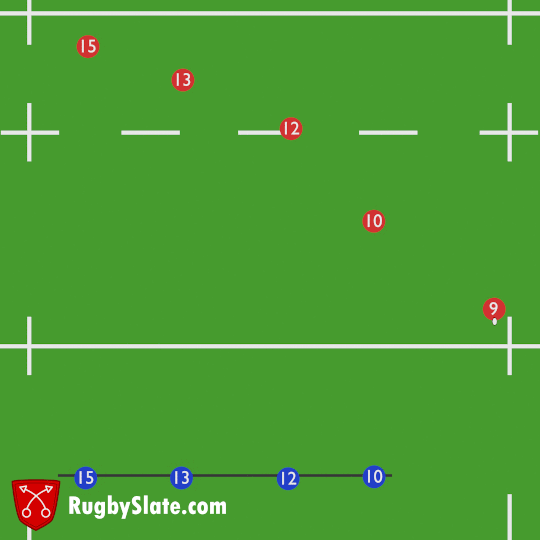Defencive Flat-Lines & Dog-Legs
One of the basic concepts to understand in terms of defence is that of a “flat line”. This is fundamental to understanding how a defence can be effective and is used through all levels of rugby. Simply put, when people mention a flat defensive line all this is referring to is having the defensive players in a single line going directly across the field. Typically you would want the defence to “come up as a flat line” as shown in the example below.
The opposite of this, is when some players either go up too quickly or too slowly causing kinks in the line and therefore creating “dog-legs”. The reason this is an issue is that any defender not in the line produces gaps which can be exploited by the attacking side. As seen in the example below, the defensive 12 does not keep in the line, meaning that there are gaps either side of them which the opposition can attack. In the example, there is a successful line break which is the worst case scenario but even if the defensive 10 did make the tackle, there is still a good opportunity for the attacking side as the point of contact is now behind where the other defensive players are. This means that the defence are offside and must retreat, additionally there is no one able to compete at the breakdown so more than likely the attacking side will get quick ball and the next phase will be against a scrambling defence. In this case it is easy to blame the 12 for being too lazy or slow for not being in the line however it is equally the responsibility of the rest of the defensive line to maintain a flat line. It is a well-known that the defensive line should only go up at the speed of the slowest player.
A defender lagging behind the line causes a number of issues but equally damaging is one player shooting up out of the line. Typically this is due to a player trying to make a big impact on the game and making a big defensive play, however it can have the opposite effect. In the above example, the attack need to be aware of the situation to be able to exploit it and make a line break, however in the example below where 13 shoots up too fast, the attack may be “gifted” opportunities for a line break. If the rushing up 13 misses their tackle, there is a large gap between 12 and 1 which will be easy to get through, shown below.
The example above shows that rushing up in defence to “make a big hit” may sound like a good idea in the heat of the moment, however it can backfire easily and the consequence can out way benefits. The most effective way to defend in the vast majority of situations is to maintain a flat defensive line. This is not only during phase play, but also when chasing a kick and during broken play where it is very tempting for each player to do their own thing a rush up as fast as possible however the same points still apply. A flat defensive line keeps the gaps small, provides support to each of the defenders and gives little opportunity for the attacking side to break through.



